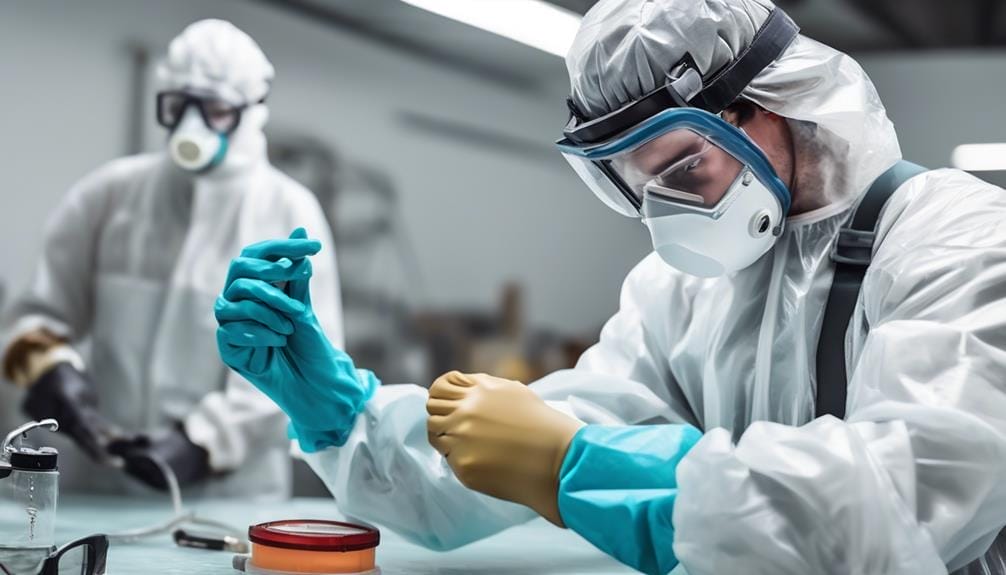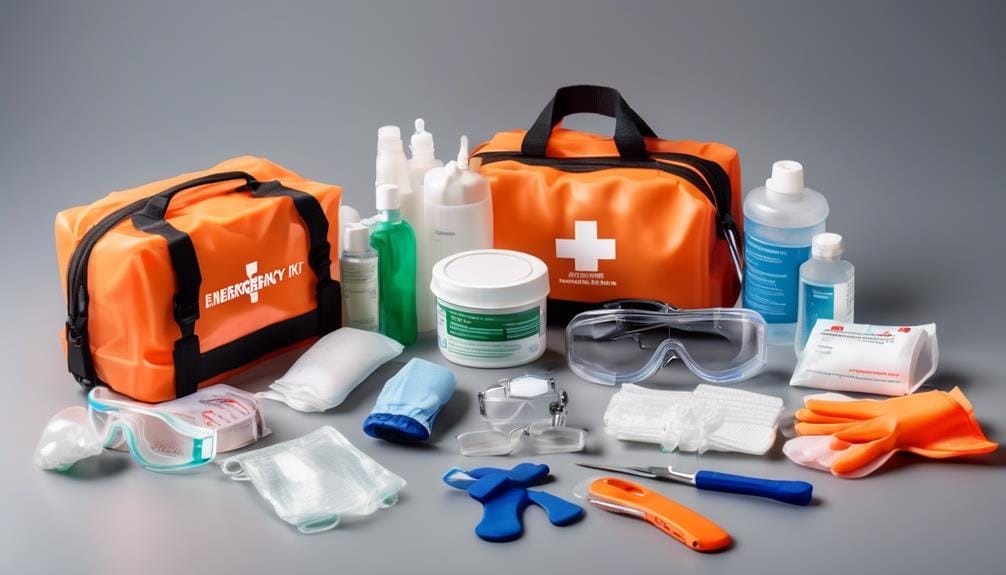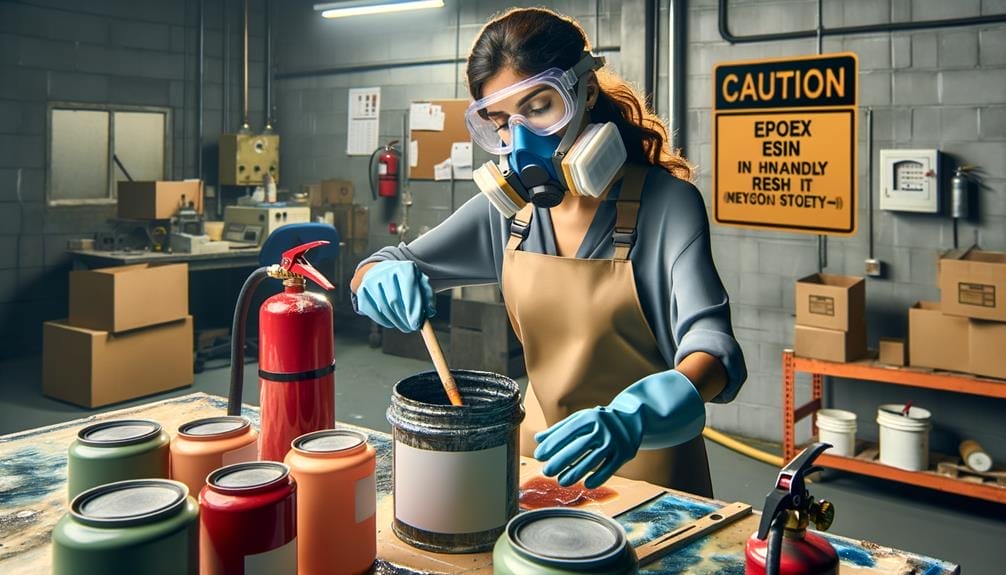Imagine you are embarking on a captivating journey into the world of epoxy resin, a substance that can be as alluring as a shimmering pearl.
But like any adventure, it is crucial to be equipped with the right knowledge and precautions to ensure your safety along the way. In this discussion, we will unveil the hidden dangers that lie within epoxy resin and explore the essential safety measures you need to take.
So, step into this realm of epoxy resin safety with caution, for there is much to learn and protect yourself from.
Key Takeaways
- Always wear appropriate protective equipment such as protective glasses, gloves, and aprons to prevent eye injuries, skin irritation, and direct contact with epoxy resin.
- Work in a well-ventilated area with proper air exchange to minimize respiratory harm and irritation caused by concentrated epoxy resin vapors.
- Use respiratory masks with organic vapor cartridges and ensure proper fit for respiratory protection, especially during sanding.
- Clean any resin off your skin immediately after working and avoid direct skin contact with epoxy resin to prevent skin irritation and harm.
Importance of Epoxy Resin Safety
Ensuring proper safety measures when working with epoxy resin is of utmost importance to protect yourself from potential health hazards.
Epoxy resin safety precautions include wearing protective glasses and gloves. Protective glasses are necessary to maintain efficient eyesight and prevent any eye injuries that may occur during handling and working with epoxy resin. They should be worn at all times to ensure proper fit and maximum eye safety.
Additionally, wearing gloves made from nitrile or vinyl is crucial to protect your skin from coming into direct contact with the resin. These gloves act as a barrier and help prevent any potential skin irritation or chemical burns that may result from exposure to epoxy resin. It's recommended to use disposable safety gloves and consider wearing plastic aprons for additional protection.
Understanding the Risks
Before you begin working with epoxy resin, it's important to understand the risks involved. Epoxy resins can pose health hazards, such as eye damage and skin irritation, if proper precautions aren't taken.
To protect yourself, it's crucial to use the appropriate protective equipment, such as gloves and goggles.
Additionally, ensure that you work in a well-ventilated area to minimize the exposure to any harmful gases emitted by epoxy resins.
Health Hazards Associated
To understand the risks associated with epoxy resin, it's important to be aware of the potential health hazards involved. Here are three key health hazards to consider when working with epoxy resin:
- Respiratory Irritation: Concentrated epoxy resin vapors can cause respiratory irritation and illness. It's crucial to work in a well-ventilated space and use proper ventilation methods to minimize the risk. Wearing a respiratory mask with an organic vapor cartridge is also recommended, especially during sanding, to protect your respiratory system.
- Skin Irritation: Epoxy resin can irritate the skin and cause harm. To protect your skin, wear gloves made from nitrile or vinyl and use disposable safety gloves. Additionally, use skin-safe cleansers to avoid skin irritation and potential harm.
- Eye Safety: Epoxy resin can be harmful to the eyes. Protect your eyes by wearing safety goggles or glasses. Ensure they fit properly and provide adequate coverage to maintain efficient eyesight and prevent any accidental exposure.
Protective Equipment Necessary
When working with epoxy resin, it's crucial to prioritize your safety by wearing the necessary protective equipment to minimize the potential health risks involved.
To protect your eyes, wear safety glasses or protective goggles that fit properly. These will shield your eyes from any splashes or fumes that may be emitted during the resin application process.
Additionally, it's important to wear a respirator mask with an organic vapor cartridge to protect against epoxy resin vapors and dust. This will ensure that you aren't inhaling any harmful chemicals.
Finally, make sure to use gloves made of nitrile or vinyl to protect your skin from the resin liquids.
Proper Ventilation Requirements
Proper ventilation is crucial for ensuring your safety when working with epoxy resin, as it helps minimize the risk of respiratory irritation and illness.
To maintain a safe working environment, follow these ventilation requirements:
- Utilize fans, open windows, and work in well-ventilated spaces to prevent concentrated epoxy resin vapors from building up.
- Ensure a complete air exchange every 15 minutes to reduce the risk of respiratory harm and irritation.
- Aim for natural air flow and air movement using ceiling or floor fans to maintain proper ventilation while working with epoxy resin.
Ventilation Requirements
Ensure optimal ventilation in your work area to prevent the accumulation of concentrated epoxy resin vapors. Proper ventilation is crucial when working with epoxy resin, especially if you're using it in a confined space or at home. Adequate ventilation helps to minimize the inhalation of harmful fumes and promotes a safe working environment.
To meet the ventilation requirements, follow these guidelines:
- Open Windows: Open windows in your workspace to allow for cross-ventilation. This will help to remove any fumes that may be released during the epoxy resin application and curing process.
- Utilize Fans: Make use of ceiling fans or additional fans to keep the air moving. This will help to disperse any fumes and ensure a well-ventilated area.
- Air Exchange: Aim for a complete air exchange every 15 minutes. This can be achieved by continuously circulating fresh air into the workspace and removing stale air.
Respiratory Protection

To protect yourself from harmful fumes and ensure respiratory safety, it's essential to wear a respiratory mask with an organic vapor cartridge while working with epoxy resin. This will help filter out the hazardous vapors and dust that can be released during the application of epoxy resin.
Here are three important points to remember when it comes to respiratory protection:
- Use separate masks for different applications: Different epoxy resin formulations may require different types of respiratory protection. Make sure to use the appropriate mask for the specific epoxy resin you're working with to ensure maximum safety.
- Proper protection during sanding: Sanding epoxy resin can release fine particles into the air, which can be harmful if inhaled. It's crucial to wear a respirator that provides adequate protection during sanding to prevent any harm to your respiratory system.
- Choose the right size and source: Refer to the epoxy resin safety data sheet to determine the respirator requirements for your specific application. It's important to choose a respirator that fits properly to ensure effective protection. Additionally, make sure to purchase the respirator and cartridges from a reputable supplier to ensure their quality and reliability.
Skin Protection Measures
Consider wearing disposable safety gloves to protect your skin from direct contact with epoxy resin liquids. It's important to choose gloves made from materials such as nitrile or vinyl, as they provide effective protection against the resin. Avoid using latex gloves, as they may not offer sufficient barrier against the epoxy resin. Wearing gloves is essential to prevent skin exposure and potential irritation. Additionally, using plastic aprons can provide an extra layer of protection against spills and drips that may come into contact with your skin.
After working with epoxy resin, it's crucial to clean any resin off your skin immediately. This can be done using baby wipes, soap, and water. Promptly removing the resin helps minimize skin irritation and ensures proper skin hygiene. It's essential to prioritize the protection of your skin when working with epoxy resin, as it can cause skin sensitization and allergic reactions in some individuals. By wearing protective gloves and using plastic aprons, you can minimize the risk of direct skin contact with the resin, safeguarding your skin from potential harm.
Eye Protection Guidelines

Wearing safety goggles or glasses is essential for protecting your eyes from epoxy resin. Here are some guidelines to ensure your eye safety:
- Ensure proper fit: It's crucial to choose safety goggles or glasses that fit your face properly. Ill-fitting eyewear can compromise your eyesight and leave your eyes vulnerable to epoxy resin splashes.
- Avoid using prescription eyewear: Regular prescription glasses aren't designed to provide sufficient protection from chemicals like epoxy resin. It's recommended to use safety goggles or glasses specifically designed for this purpose.
- Contacts for comfort and protection: If you wear contact lenses, they can be a suitable alternative to glasses. However, it's important to note that contacts alone may not offer complete protection. It's still necessary to wear safety goggles or glasses over your contacts to ensure maximum eye safety.
Proper Mixing Techniques
For proper mixing techniques of epoxy resin, ensure accurate measurement of the resin and hardener to achieve the desired chemical reaction. When working with epoxy resin, it's crucial to wear appropriate Personal Protective Equipment (PPE) to prevent any potential skin irritation.
Once the resin and hardener are accurately measured, thoroughly mix them together for at least 3 minutes. Use a mixing container and make sure to scrape the sides and bottom to ensure a complete blend. Avoid vigorous mixing, as it can introduce air bubbles into the mixture, compromising the final result.
If air bubbles do appear, consider using a heat gun or torch to remove them after pouring the resin. It's important to follow the manufacturer's instructions for the specific epoxy resin product being used, as different products may have specific mixing requirements.
Choosing the Right Protective Gear

To ensure your safety when working with epoxy resin, it's essential to choose the right protective gear. Here are three items of protective gear that you should consider:
- Respiratory Mask: Wear a respiratory mask with an organic vapor cartridge to protect against vapors and dust. This will help prevent respiratory system harm and illness.
- Gloves and Aprons: Use gloves made from nitrile or vinyl to provide protection for your hands. Additionally, consider wearing plastic aprons for additional skin protection. This will help minimize the risk of skin contact with epoxy resin.
- Safety Goggles or Glasses: Protect your eyes from epoxy resin by wearing safety goggles or glasses. Ensure that they fit properly for efficient eyesight and maximum eye safety.
When choosing protective gear, it's important to prioritize your safety by selecting gear that's appropriate for working with epoxy resin. Make sure to choose epoxy resin that's non-toxic, safe for home use, and VOC-free to minimize health risks.
Remember to work in a well-ventilated area and use a respirator if necessary to limit exposure to epoxy dust and fumes. By choosing the right protective gear, you can ensure a safer working environment when using epoxy resin.
Handling and Storing Epoxy Resin
When handling and storing epoxy resin, there are important precautions to keep in mind.
Proper storage techniques involve keeping the resin in a cool, dry place away from direct sunlight and heat sources, while ensuring containers are tightly sealed to prevent evaporation and contamination.
Additionally, it's crucial to handle epoxy resin safely by storing it away from food, drinks, and open flames to avoid accidental ingestion and fire hazards.
Proper Storage Techniques
Properly store epoxy resin in a cool, dry place away from direct sunlight and heat sources to prevent premature curing and degradation. Here are some important tips for storing epoxy resin:
- Keep epoxy resin containers tightly sealed when not in use to avoid contamination and evaporation.
- Store epoxy resin away from food, drinks, and areas where food is prepared to prevent accidental ingestion or contamination.
- Store epoxy resin away from children and pets to prevent accidental exposure and ingestion.
Using dedicated storage containers and shelves for epoxy resin is also recommended to prevent cross-contamination with other materials and chemicals.
Handling Precautions
Ensure safe handling and storage of epoxy resin by following these important precautions.
- Protect yourself by wearing the appropriate protective gear when using epoxy resins. This includes wearing gloves made from nitrile or vinyl and disposable safety gloves to avoid direct skin contact with the resin.
- Work in a well-ventilated area to prevent the concentration of epoxy resin vapors, which can cause respiratory irritation. Make sure to wear safety goggles or glasses to shield your eyes from accidental splashes or exposure.
- When mixing materials, avoid using those that prevent epoxy resin from curing. It is also important to ensure proper ventilation during curing to minimize the buildup of harmful chemicals.
- Use a NIOSH-approved respirator for fumes to limit exposure to epoxy dust and reduce respiratory risks.
Remember to stay safe while handling epoxy resin!
Safety Equipment Requirements
To handle and store epoxy resin safely, it's important to have the appropriate safety equipment in place. When working with epoxy resin, you need to wear protective gear to ensure your safety.
Here are three essential safety equipment requirements:
- Gloves: Wear gloves, preferably nitrile or latex, to protect your hands from direct contact with resin liquids. This will prevent skin irritation and potential chemical burns.
- Safety goggles: Protect your eyes from epoxy resin by wearing safety goggles. This will shield your eyes from any splashes or accidental contact, reducing the risk of eye damage.
- Respirator or well-ventilated area: Work in a well-ventilated space to prevent inhaling potentially harmful fumes. If adequate ventilation isn't available, use a respirator that meets the requirements specified in the epoxy resin safety data sheet. This will protect your respiratory system from any hazardous vapors.
Dealing With Allergic Reactions
If you experience any allergic reactions to epoxy resin, it is important to seek medical attention and discontinue use immediately. Allergic reactions to epoxy resin can vary from mild skin inflammation, redness, or irritation to more severe symptoms such as swelling or fluid-filled blisters. It is crucial to consult a medical professional if you notice any allergic reactions. Individuals with known allergies should avoid using epoxy resin to prevent allergic reactions.
To further understand and manage allergic reactions to epoxy resin, refer to the following table which highlights important safety precautions and first aid measures:
| Safety Precautions | First Aid Measures | Reference (ASTM D) |
|---|---|---|
| Wear protective gloves, clothing, and eyewear when working with epoxy resin. | In case of skin contact, wash the affected area with soap and water. | ASTM D4236 |
| Work in a well-ventilated area or use respiratory protection to avoid inhaling resin particles. | If epoxy resin gets in your eyes, flush with water for 15 minutes and avoid rubbing. | ASTM D1259 |
| Follow the manufacturer's instructions for proper handling, storage, and disposal of epoxy resin. | If you accidentally ingest epoxy resin, do not induce vomiting. Seek immediate medical attention. | ASTM D6056 |
Remember to consult the Safety Data Sheet (SDS) provided by the epoxy resin manufacturer for detailed health information and safety guidelines. By following these precautions and taking prompt action in case of an allergic reaction, you can ensure your safety when working with epoxy resin.
Emergency Measures and First Aid

In the event of accidental skin contact with epoxy resin, promptly wash the affected area with soap and water. It's important to make sure that all the resin is thoroughly removed from the skin. Seek medical attention if irritation or redness persists.
In case resin comes into contact with your eyes, it may cause eye irritation and potential damage. Flush your eyes with water for at least 15 minutes and seek medical attention immediately.
If you accidentally ingest epoxy resin, it's crucial to seek medical attention right away. Don't induce vomiting unless directed by a medical professional.
Inhaling epoxy resin may cause respiratory irritation. If you experience any discomfort, move to an area with fresh air and seek medical attention if the symptoms persist.
Always wear personal protective equipment, such as gloves and goggles when working with epoxy resin to minimize the risk of accidental skin contact or eye injury.
Having emergency contact information readily available, including the resin manufacturer's information, is essential for prompt medical attention if needed.
Safe Disposal of Epoxy Resin Waste
After taking the necessary safety precautions and addressing any potential emergencies, it is important to understand the proper methods for disposing of epoxy resin waste. Proper disposal is crucial to protect the environment and ensure your safety during and after your resin project. Epoxy resin waste can be harmful if not disposed of correctly, so it's essential to follow the guidelines below for safe disposal:
| Waste Type | Disposal Method | Notes |
|---|---|---|
| Liquid epoxy resin waste | Allow the resin to cure completely and dispose of it as solid waste. | Once the resin has hardened, it is considered non-toxic and can be thrown away with regular trash. |
| Excess mixed epoxy | Allow it to cure in a disposable container and dispose of it as solid waste. | Do not pour excess mixed epoxy down the drain or into the environment. |
| Empty resin containers | Clean them thoroughly with soap and water. | Make sure to remove any remaining resin and dry the containers before recycling or disposing of them. |
| Tools and brushes with dried resin | Scrape off excess resin and dispose of it as solid waste. | Clean the tools with acetone or a resin cleaner before reuse. |
Frequently Asked Questions
Is Epoxy Resin Toxic to Breathe?
Breathing in epoxy resin can be hazardous. Ensure proper ventilation, use a mask with organic vapor cartridge, and follow handling techniques to avoid respiratory issues. Long-term exposure may have health effects.
Is Epoxy Resin Safe to Use at Home?
Using epoxy resin at home is safe if you follow precautions. Clean spills immediately, ensure proper ventilation, allow sufficient curing time, and dispose of waste properly. Protect yourself with PPE to minimize risks.
Do You Need to Wear a Mask When Using Epoxy Resin?
Yes, you should wear a mask when using epoxy resin for your own respiratory protection. It helps minimize health risks caused by inhaling vapors. Make sure to work in a well-ventilated area and follow recommended safety equipment guidelines.
Do You Need PPE for Epoxy Resin?
Yes, you need PPE for epoxy resin. Types of PPE include gloves, safety goggles, and a respiratory mask. These precautions protect against potential hazards such as skin contact, eye irritation, and inhalation of vapors or dust.
Conclusion
In conclusion, ensuring proper safety precautions when working with epoxy resin is crucial. From wearing respiratory masks to following ventilation guidelines, these measures help minimize the risk of respiratory harm.
Additionally, protecting the skin and handling the resin correctly are essential steps to avoid allergic reactions.
In the event of an emergency, knowing first aid techniques is important.
Lastly, disposing of epoxy resin waste safely is necessary for environmental protection.
Are you ready to prioritize safety when working with epoxy resin?





